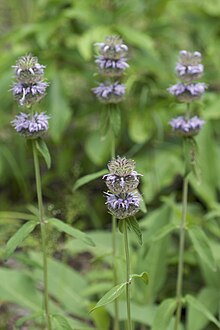Blephilia ciliata
| Blephilia ciliata | |
|---|---|

| |
| Scientific classification | |
| Kingdom: | |
| (unranked): | |
| (unranked): | |
| (unranked): | |
| Order: | |
| Family: | |
| Genus: | |
| Species: | B. ciliata
|
| Binomial name | |
| Blephilia ciliata | |
Blephilia ciliata is an herbaceous perennial of the mint family Lamiaceae native to eastern North America. It is commonly called downy wood mint. Other common names include downy pagoda plant, sunny woodmint and Ohio horsemint.[1]
Carl Linnaeus described the downy wood mint as Monarda ciliata, before George Bentham gave it its current binomial name.[2]
Blephilia ciliata grows as a perennial herb reaching 40 to 80 cm (15.5 to 31.5 in) high.[3]
It was traditionally used by the Cherokee to make a poultice to treat headaches.[4]
References
- ^ Lady Bird Johnson Wildflower Center (19 February 2009). "Blephilia ciliata (Downy Pagoda Plant)". University of Texas at Austin. Retrieved 11 December 2011.
- ^ Bentham, George (1836). Labiatarum genera et species: or, A description of the genera and species of plants of the order labiatae; with their general history, characters, affinities, and geographical distribution. London: James Ridgway and Sons. p. 319.
- ^ Miller, James Howard; Miller, Karl V. (2005). Forest plants of the Southeast and their wildlife uses. University of Georgia Press. p. 22. ISBN 0-8203-2748-4.
- ^ Hamel and Chiltoskey, Paul B., and Mary U. (1975). Cherokee Plants and Their Uses - A 400 Year History. Sylva, N.C.: Herald Publishing Co. p. 45.
{{cite book}}: CS1 maint: multiple names: authors list (link)
